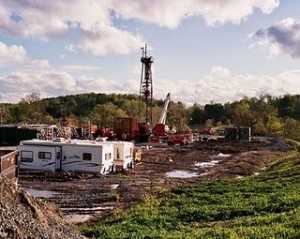What the Frac? Pollution from the use of thousands of chemicals to derive natural gas from shale is threatening the health of our children and every other living thing.
 By Nancy Chuda, Founder and Editor in Chief LuxEco Living and Founder of Healthy Child Healthy World
By Nancy Chuda, Founder and Editor in Chief LuxEco Living and Founder of Healthy Child Healthy World
My dear friend Olivia Newton-John Easterling called me the other day and asked if I had ever heard of fracturing or fracking? She was livid! Queensland Australia is now a hot bed issue due to the governments invasive efforts to create a zillion dollar industry from the production of natural gas. As Healthy Child’s first National Spokesperson and a Goodwill Ambassador to the United Nations, Olivia has very good reasons for being alarmed.
For years science has indicated a growing concern surrounding the release of endocrine disruptors. In the early 1990’s, it was revealed that the traditional toxicological testing protocols used to determine chemical safety had completely missed vast numbers of chemicals that penetrate the womb and interfere with the construction and programming of developing animals, including humans. Since that time, overwhelming evidence has accumulated indicating that the presence of infinitesimally small quantities of certain chemicals during the continuously changing stages of development before birth can alter one’s inherited phenotype, e.g., the ability to learn, to love, to bond, to process information, to reproduce, and even to maintain normal body weight. Because these chemicals interfere with development by disturbing the function of the endocrine system, they are called endocrine disruptors. The endocrine system is so fine tuned that it depends upon changes in hormones in concentrations as little as a tenth of a trillion of a gram to control the womb environment. That’s as inconspicuous as one second in 3,169 centuries.
TEDX was founded by Dr. Theo Colborn whose life long dedication to this issue reveals evidence that many chemical substances can cause a range of adverse health problems, including death, cancer, birth defects, and delays in development of cognitive functions.
This is one reason why our health care crises continues to escalate. Billions of dollars are appropriated towards finding cures. While Research Triangle, the hub for NIH, continues its efforts to find the links between human health, genetics and the environment, more and more untested chemicals are released into the environment each year. Having been appointed by Secretary of Health Donna Shalala, I served as an Advisory Council Member to the National Institutes of Environmental Health Sciences. During my five-year tenure I reviewed grant applications for the funding of numerous studies linking toxic chemicals to human health. We explored exposures in fetal development which later led to the National Children’s Study which began in 2008. We funded a dozen universities and created the first national environmental health children’s centers that looked at pesticides and other chemicals many known to cause cancer. And in all the research that has been funded we are closer to understanding the potential hazards due to chemical exposures yet the technologies associated with the production of many alternatives have become even more hazardous.
 Natural gas production may seem like a replacement for coal and nuclear but at its core it may be responsible for the contamination of essential life support systems-water, air, and soil- and causing harm to the health of humans, wildlife, domestic animals, and vegetation. What’s at stake? Not less pollution but more!
Natural gas production may seem like a replacement for coal and nuclear but at its core it may be responsible for the contamination of essential life support systems-water, air, and soil- and causing harm to the health of humans, wildlife, domestic animals, and vegetation. What’s at stake? Not less pollution but more!
According to a new report released by TEDX toxic chemicals are used at every stage of development to reach and release the gas. Drilling muds, a combination of toxic and non-toxic substances, are used to drill the well. To facilitate the release of natural gas after drilling, approximately a million or more gallons of fluids, loaded with toxic chemicals, are injected underground under high pressure. This process, called fracturing (frac’ing or stimulation), uses diesel-powered heavy equipment that runs continuously during the operation. One well can be frac’ed 10 or more times and there can be up to 28 wells on one well pad. An estimated 30% to 70% of the frac’ing fluid will resurface, bringing back with it toxic substances that are naturally present in underground oil and gas deposits, as well as the chemicals used in the frac’ing fluid. Under some circumstances, nothing is recovered.
What’s the problem? There are hundreds of products in current use, the components of which are, in many cases, unavailable for public scrutiny.
 Whose at risk? Everyone and all living things that lives near or within a geographical location where the production of natural gas exists. Here in the US potable and arable water resources in the West are already marginal and especially vulnerable to contamination. Mountain watersheds that provide drinking and irrigation water for vast numbers of people downstream are at risk of contamination as a result of the Bureau of Land Management (BLM) leasing of hundreds of thousands of acres of underground mineral and gas resources to energy developers. Just as there is no accounting for what happens to the millions of gallons of fluids used to drill and fracture each well, there is no accounting for the source of the water being taken to complete these processes, how much of the fluid is water, and where and in what condition it is returned to the watershed.
Whose at risk? Everyone and all living things that lives near or within a geographical location where the production of natural gas exists. Here in the US potable and arable water resources in the West are already marginal and especially vulnerable to contamination. Mountain watersheds that provide drinking and irrigation water for vast numbers of people downstream are at risk of contamination as a result of the Bureau of Land Management (BLM) leasing of hundreds of thousands of acres of underground mineral and gas resources to energy developers. Just as there is no accounting for what happens to the millions of gallons of fluids used to drill and fracture each well, there is no accounting for the source of the water being taken to complete these processes, how much of the fluid is water, and where and in what condition it is returned to the watershed.
In addition to the land and water contamination issues, at each stage of production and delivery, tons of toxic volatile compounds, including benzene, toluene, ethylbenzene, xylene, etc., and fugitive natural gas (methane), escape and mix with nitrogen oxides from the exhaust of diesel-driven, mobile and stationary equipment to produce ground-level ozone. Ozone combined with particulate matter less than 2.5 microns produces smog (haze). Gas field produced ozone has created a serious air pollution problem similar to that found in large urban areas, and can spread up to 200 miles beyond the immediate region where gas is being produced. Ozone not only causes irreversible damage to the lungs, it is equally damaging to conifers, aspen, forage, alfalfa, and other crops commonly grown in the West. Adding to this is the dust created by fleets of diesel-driven water trucks working around the clock hauling the constantly accumulating condensate water from well pads to central evaporation pits. What makes matters worse is the combination of fracking fluids and the contaminated water which surfaces with the gas. This so called (Produced water) is found in most regions where gas is extracted and continues to surface for the life of the well (20 to 30 years).
Over the years, the National Institute of Environmental Health Sciences (NIEHS) has been concerned with the contamination from superfund sites. Fracking is adding more to the arsenal. Many of the chemicals found in drilling and evaporation pits are considered hazardous wastes by the Superfund Comprehensive Environmental Response, Compensation, and Liability Act (CERCLA). Upon closure, every pit has the potential to become a superfund site.
 What’s the bottom line? Moving David to face Goliath in what will become one of the largest international public health debates of this century. From the land down under, Australia, and across the sweeping plains of America, people will have to make a choice whether to take the money “big gas” is willing to pay or pay an even greater price. Declining health due to the intolerable risks of exposure to chemicals affecting present and future generations yet unborn.
What’s the bottom line? Moving David to face Goliath in what will become one of the largest international public health debates of this century. From the land down under, Australia, and across the sweeping plains of America, people will have to make a choice whether to take the money “big gas” is willing to pay or pay an even greater price. Declining health due to the intolerable risks of exposure to chemicals affecting present and future generations yet unborn.
As we gaze at Google Maps across sea from air it appears natural gas lines will be spreading, cancer-like networks of dirt roads over vast acreage, contributing to desertification, and jeopardizing the health of children born and yet conceived will be dodging the debt for the high price of gas.
Learn more about the issues surrounding Fracking and retrieving natural gas from shale, watch CBS’s 60 Minutes riveting report.













